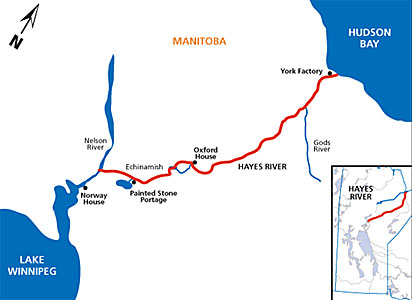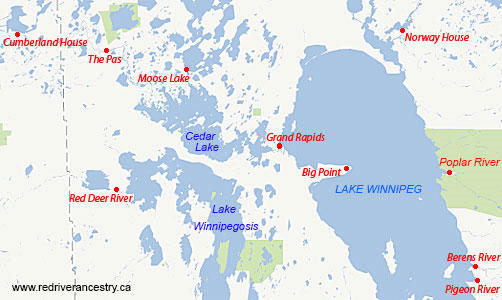PRICE ISHAM aka ASHAM (1789-1833+) (Last Updated: August 31, 2016)
Heather McDobie has done some excellent research and detective work regarding Price ASHAM, and I (Gary Still) hope to work with her further in developing his lineages. Her comments appear under several Forum Topics on my website. She and Don Larsen provided the inspiration for this narrative. They are both presumed to be descendants of Price ASHAM.
The first postings by Both Heather and Don on my Forum appeared back in 2011 at this link:
According to Sprague & Frye, Price ASHAM was born about 1789 in the Northwest (Rupert Land). Apparently Price was a child of an Indian woman and Charles Thomas Price ISHAM (1755-1814) in which case he was probably born in the Swan River District. ** MORE ABOUT CHARLES THOMAS PRICE ISHAM
It seems to be generally understood that the surname ISHAM later became ASHAM the spelling most commonly used by his descendants.
Arrival of the first Selkirk Settlers
On Sep 24, 1811, Miles MACDONELL (1767-1828), slated to be the new Governor of Assiniboia, arrived at York Factory with the first contingent of Lord Selkirk’s settlers, too late in the season for a long overland trek inland. They had to winter in log huts several miles up the Nelson River.
The Hayes River Route taken by the Selkirk Settlers
DCBO:In 1814 Charles Thomas (Price) ISHAM died in England. At his death ISHAM’s estate, which amounted to £1,800 in three per cent annuities, benefited four Hudson Bay children, Thomas, Mary, Jane, and James, designated as natural; like older colleagues such as Malchom ROSS and George ATKINSON, and unlike some later traders, he did not seek to affirm their legitimacy. Thomas and one Price ISHAM were company labourers in the Winnipeg district at the time of his death, and ISHAMs appear in later Red River mission records.
It seems that Asham PRINCE and Price ASHAM are very likely one and the same person.Sprague & Frye identifies Asham PRINCE as born in 1800, his wife as Ann LEASK. Sprague & Frye is notorious for erratic information, particularly with regard to birth dates.
Lake Winnipeg District
In 1814 Price would have been about 25 years old when his father died in England. Jennifer Brown indicates that the ISHAM family were Company labourers in the Lake Winnipeg District at the time of their father’s death and that ISHAM’s appear in later Red River Mission records.
Frontier School Division (FSD) research indicates that “Kishecathin, Huggemowappew {Price ISHAM), Thomas ISHAM (Price’s brother) and William LEASK [future father-in-law of Price ISHAM), Mantootackoos [brother-in-law of Thomas ISHAM]” were listed in that order in the Norway House Debt List for 1816/17, kept by James KIRKNESS (1774-1843).
Union of the North West Company with the Hudson’s Bay Company
In 1821 the union of the North West Company (NWC) and the Hudson’s Bay Company (HBC) occurred, ending the years of bitter rivalry for dominance of the fur trade in Western Canada. After the merger, almost 1,300 employees lost their jobs since the single HBC organization that emerged had no need for most of the voyageurs and fur traders.
At the time of the HBC-NWC union, (Sir) George SIMPSON (1786-1860) became the Governor of Rupert’s Land. On May 20, 1822, SIMPSON reported to the board of governors of the HBC that he had established a fort at the junction of the Red and Assiniboine Rivers. He named it Fort GARRY (the Upper Fort). Around this fort was to grow the city of Winnipeg.
Also at the time of the Union, Reverend John WEST (1778-1845) arrived from England as the first Chaplain in the northwest. He was sponsored by the Church Missionary Society (CMS) and the HBC. Governor SIMPSON and the HBC expected him to devote most of his efforts at providing religious services to the white settlers, but WEST had an agenda of his own. His passion was his missionary work with the Indians. Almost from the day he arrived at York Factory, he began to recruit Indian youngsters for the school he would build near the Forks (St Johns).
Price and Hannah LEASK
Around 1822 (as indicated below) Price’s wife was Hannah LEASK, daughter of Mary Polly COOK & William LEASK (1795-1881) who lived in St Peters.
Daughter Ann born in 1822:
Son James bourn about 1823:
Norway House
In his Thesis about Norway House, James McKILLIP frequently refers to Price ISHAM as “Huggy” and “Hoggee”. For example, he mentions Huggy ISHAM arriving back at Norway House with his family on Christmas Eve, 1825.
The following includes many excerpts from the McKillip Thesis:
- By the mid 1820’s, as a result of changes made following the merger of the Hudson’s Bay (HBC) and North West Companies, Norway House had become a crucial elements in the transportation arrangements of the HBC and getting back in full operation had become a critical task. The work was begun by John Peter PRUDEN (1778-1868), but in 1826 the task was handed over to John McLEOD (1788-1849). McLEOD had charge of Norway House, which he built, and which was the rendezvous of all important trade-brigades from the interior. Here the chief council for the government of the trade met annually until a few years ago, when the place of meeting was transferred to Winnipeg - At the end of the 1826 season, McLEOD was compelled to hire freeman Huggy ISHAM for,” - - preparing timbers and bark to repair a big canoe of which the bark and timbers were stolen by the passants.
- As of May 1827 the only people known to be actually living at Norway House other than HBC personnel and 17 women and children ‘of the post’ were the freeman Huggy ISHAM and his family and the four men - -
- By the end of the summer of 1827, two fundamental conditions had changed at Norway House. First, any idea that the tiny number of staff permanently assigned to the post was sufficient to advance the construction of the new depot and simultaneously operate a fishery that would supply both the large transient summer population and the needs of the brigades for provision was clearly gone. Even the addition of extra personnel for the winter, ostensibly dedicated to the establishment of a fishery, did not solve the problem. Although there had been some limited hiring of local labour before this, by June 1827 John McLEOD had begun to employ casual labour for various tasks on a routine basis.
- Some additional help came on the 16th of the month (October, 1827) when a boat, bound for York Factory from Red River, dripped off one man, Price ISHAM, who was planning to remain at Norway House for the winter.
- 1827-1828: ISHAM only remained at Norway House until the 25th (Oc5 25, 1827) after which he departed to his own fishery, apparently with 3 or 4 people from his own family that had been at the post.
In 1830 Donald ROSS (1798-1852) was placed in charge of the post at Norway House in 1830. The neighboring Village of Rossville was named after him. ** MORE ABOUT DONALD ROSS and NORWAY HOUSE
- In 1830 the freeman Huggy ASHAM, now a permanent fixture at Norway House, was hired, along with his son to conduct a fishery over the winter.
- In the spring of 1832, “Hoggee” [Price ISHAM] was sent from the post “with Supplies of ammunition to Curly Head’s party at the Grand Rapid and to bring back their winter hunts.” In September 1832, “Curly Head and his Sons went off to the Grand Rapids after getting their winter Supplies” and in March 1833, “Sent Hoggee and Custatag off towards Moose Lake to look after Curly Heads band with supplies of Ammunition, and to bring home the few furs they might have collected in course of the winter. They returned in April “with 170 Made Beaver in Furs.” ================ End of McKillip References ================
From the foregoing it appears that Price ISHAM lived a somewhat nomadic existence. In his early years we find him in the St Peters Reserve (Netley Creek area) and at various places along the fur-trade routes between Red River and York Factory. He spent a lot of time in the Lake Winnipeg district, mostly at Norway House (sometimes at Grand Rapids) where he worked for John McLEOD.
So far we don’t know much about Hannah and Price ISHAM after 1833 when they were at Norway House. From Ken Land (Slang1148) on the Forum: Price ISHAM is in the Red River Settlement Census for 1838, 1840, and 1843. He lives and farms 2 acres in Swampy Village. When and where did they die? If anyone has more information, please let us know on the Forum.
Around 1844-45 son James married Elizabeth BEAR, a Cree Indian, daughter of A-KEE-NA-A-SON & WAPASK or WHITE BEAR (1780-1844). ** MORE ABOUT WHITE BEAR
Around 1848 daughter Hannah married John LAMBERT, son of Margaret FAVEL & Michel LAMBERT (1792-1875).
Please post comments and queries at this link: FORUM DISCUSSING the PRICE ASHAM FAMILY
========================== Family Details ==========================
Children: 2. 1823 JAMES ASHAM (m. Elizabeth BEAR)
=========================== Notes & References ===========================
NORWAY HOUSE THESIS by JAMES McKILLIP
FRONTIER SCHOOL DIVISION SOCIAL STUDIES / NATIVE STUDIES DEPARTMENT
|


